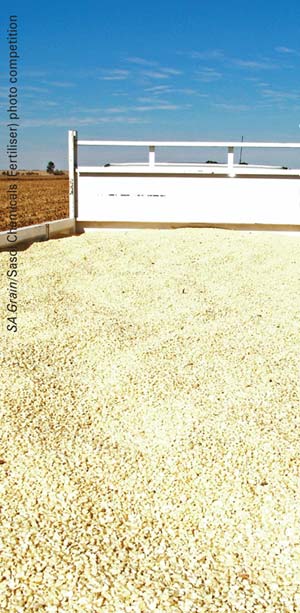June 2015
— Basis Futures coming next
CHRIS STURGESS, director: Commodities and Key Client Management, Capital Markets, JSE
There has been much published about the JSEs reference to location differentials in order to accommodate physical delivery in completion of a futures contract, particularly where a single point is referenced; as well as the need for improved transparency around basis premiums.
The JSE Commodity Derivatives Market, previously operating under the Safex brand, strives to provide market participants with a price discovery mechanism and a price risk management facility through which to manage exposure to adverse price movements in the underlying cash market and where performance by both counterparties to the contract is guaranteed.
As it is critical to ensure that the futures prices, particularly those futures contracts approaching expiry, reflect the supply and demand situation in the underlying cash market, the derivatives market focuses on providing an efficient and readily accessible physical delivery platform. The process thereby ensures price convergence of the cash and futures markets at expiration.
As the South African agricultural derivatives market has matured, so the exchange’s physical delivery processes have evolved. It started out with a random allocation process that was tweaked later with the introduction of a platform where product delivered via a Safex silo receipt, now known as a JSE silo receipt, was then available for auction to all interested buyers in the market.
In 2012 there was a move to introduce functionality to allow for basis premium trading, as an alternative to the physical delivery process in completion of a futures contract. Now in 2015, the JSE aims to extend its reach by introducing Basis Futures contracts on single delivery points thereby allowing sellers and buyers an opportunity to agree a premium at a specific delivery point for a future-dated delivery.
It is important to distinguish between the current spot basis trading platform and the envisaged Basis Futures contract. The trading of spot basis premiums referencing JSE silo receipts is an initiative that is beginning to gain more and more traction among market participants with an opportunity to trade grain at a JSE registered delivery point as represented by JSE silo receipts at a price over and above the futures price less the location differential.
Clients who have an interest in taking delivery during the futures delivery month have an opportunity to bid on preferred locations. At the same time, clients who have access to physical grain on JSE silo receipts have an opportunity to offer the stock at a premium to secure a better basis premium. This provides price discovery in terms of the spot basis premium and transparency for the entire grain market to benefit from. It is imperative to note that for efficient price discovery there must be enough liquidity or trading activity to ensure a fair representation of the basis premium.
Still not sure what a basis premium is all about? Consider that grain stored in a silo, bag or bunker site has a different value across grain of the same quality stored in other parts of the country. What influences this difference in price is a factor of supply and demand per delivery point or more commonly referred to as basis. So if you have grain in an area where there is a high demand for the commodity, this could either stem from a number of buyers competing for the product or due to limited supply and for logistic reasons buyers are prepared to pay a premium for the product and a basis premium comes about for product at a specific delivery point. A basis premium is also something that can vary significantly across the marketing season as factors influencing supply and demand varies.
In terms of opportunities using the JSE Spot Basis Premium contracts, clients no longer require an existing futures position to participate. However, should the orders entered be successful, participants will either be required to open a futures position during the remainder of the trading session or alternatively be provided with an equal short and long futures position when the physical delivery is processed, that same afternoon after close of the agricultural derivatives market.
Example
We appreciate the Basis Futures process is described in detail, to explain the concept using a simple example:
Assume a producer who aims to deliver at Kroonstad is interested in securing a Basis Future contract for July 2015 white maize (WMAZ) at a level of -R60 on 4 March 2015. There is a willing buyer who agrees to trade 50 contracts at this level of -R60 and therefore expects delivery can commence from either 1 July 2015 through until 6 July 2015 (five business days from last trading day which will be 29 June 2015). The Basis Future contract code would be displayed as WKRO 29 June 2015 [W=white maize, KRO=code for Kroonstad, 29 June 2015 is last trading day for the contract].
On 9 April the same producer hedges his overall price risk on a WMAZ contract at R2 700.
On 29 June 2015, last trading day the WKRO contract the final mtm is -R50, implying that the producer would have paid in R10 variation margin to the buyer. On 1 July 2015 the producer tenders notice of physical delivery via a JSE silo receipt and this is then linked back to the short WMAZ position held; the July 2015 WMAZ mtm is now R2 600, this implies the producer would have received R100 variation margin as the WMAZ futures hedge fell from R2 700 to R2 600. The invoice price for the producer is then calculated as follows assuming no outstanding storage = R2 600 -R50 = R2 550 is paid for the stock delivered in Kroonstad. If we consider the original hedge value of R2 700 -R60 = R2 640 and compare this with the final invoice price, do not forget the producer received R100 (from the WMAZ contract) and paid out R10 (from the WKRO contract) therefore resulting in a net amount of R90 received. This R90 added to the R2 550 invoiced value results in R2 640 – back to the original hedged value.
Combining a standard futures contract to manage the overall price risk of the commodity, but also secure the basis premium.
Function
Now to explain how the much awaited Basis Futures contract is envisaged to function: The trading platform will be extended where premiums could be transacted with a future-dated delivery obligation, hence the introduction of Basis Futures. There is therefore no need to have the physical product on JSE silo receipts in order to secure a basis premium.
The proposed contract design for a Basis Futures contract is that this will form an extension of the current deliverable grain futures contracts and included in the detailed agricultural contract specifications as an additional appendix. We expect the following to be approved by the clearing members and various risk committees:
- Basis Futures – defined as the location premium or discount that the buyer and seller agree on, for a future-dated obligation to either make or take physical delivery at the specified registered delivery point.
- Futures contracts will be available for all major grain products, namely white and yellow maize, wheat, soybeans and sunflower seeds.
- Only five main hedging month expiries will be available where basis futures can be secured, namely March, May, July, September and December. Listing of expiries per registered delivery point will be demand-driven and subject to an initial interest to either bid or offer 50 contracts or more.
- The Basis Futures will price at a premium or discount to the reference deliverable grain futures contract and will not include any location differential component. In other words should the Basis Futures contract, referencing WMAZ as the underlying product, trade at +10 and assuming the WMAZ contract is trading at R2 600/ton, then this represents R10 over and above R2 600 for the white maize delivery at the specific delivery point. No reference to a location differential will be included in any of the basis futures pricing. Should the Basis Future trade at -50 and assuming WMAZ is trading at R2 600, then this represents delivery of white maize at the specific delivery point R50 under the R2 600 level or R2 550 should the client lock in both the underlying WMAZ hedge as well as Basis Future.
- The underlying contract specifications in terms of contract size and deliverable qualities will align with the listed grain futures contract e.g. Basis Futures listed on white maize will see one contract represent 100 tons of WM1 grade maize.
- The Basis Futures contract will be quoted anonymously in a similar fashion to the Spot Basis contracts so as not to disclose the participants actively quoting and encouraging bids and offer to come through the central order book.
- The Basis Futures contract, introduced in the trading system as a separate futures contract, will be margined and subject to a daily mark-to-market (mtm) relying on the existing JSE methodologies applicable to the derivatives market. Initial margin is expected to be referenced back to the cash settlement penalty until the JSE is able to build up more historical data around basis values traded.
- Clients can trade the Basis Futures contract independently of the underlying deliverable grain futures contract, in other words, lock in the basis premium or discount and then at a later date hedge the overall price risk for the underlying commodity. Only at expiration will a position in the deliverable grain futures contract be required, but if this is not available, an equal and opposite futures positions will be opened similar to the spot basis market today.
- Since the Basis Futures contract ultimately is an extension of the deliverable grains contract, whereby at expiration, physical delivery is required and matched with a futures position in the deliverable grain contract, the Basis Futures contract’s last trading day will be first position day as defined for the deliverable grains contract, with physical delivery processed for five business days following last trading day.
- Therefore all short position holders who have a Basis Futures position following last trading day, will be obligated to tender a JSE silo receipt in the registered delivery point as per the listed Basis Futures contract for the defined underlying product, with last notice day described as five business days following last trading day. Should the short position holder not have a corresponding short futures position on the deliverable grain contract e.g. WMAZ, then the position holder will receive both a short and long futures in WMAZ in order to process the physical delivery – this is similar to the process in the Spot Basis contract.
- The long position holders who have a Basis Futures position following last trading day, will be obligated to take delivery and make full payment for product represented by a JSE silo receipt in a specific registered delivery point referencing the underlying deliverable grain contract, with delivery triggered by the short position holder.
- The long position holder can therefore expect notice of delivery any day following last trading day within a five business day period. Since a long position is required in the deliverable grain futures contract e.g. WMAZ to process the delivery, if this is not available a corresponding long and short futures position will be created to accommodate the physical delivery – this is similar to the process in the Spot Basis contract.
- Settlement invoicing and processing transfer of payment of the Basis Futures contract is thus done in a similar manner to the current invoicing process except there will be no inclusion of the location differential where applicable. The final Basis Futures mtm will be referenced as at last trading day against the deliverable futures mtm on the notice day of delivery in order to calculate the final invoice value.
- The requirements to introduce registered delivery points as a Basis Future will be as follows:
- We appreciate the JSE currently has over 250 registered delivery points, and while we had considered consolidating delivery points to link to a specific Basis Future, our ultimate proposal to allow for the most efficient pricing is to allow for each registered delivery point to trade at its own basis premium or discount.
- The introduction of a specific delivery point will be subject to the firm commitment to either bid or offer 50 futures contracts (this then translates into either 5 000 tons or 2 500 tons depending on the underlying product). The idea behind this is to ensure focus around specific delivery points where there is increased demand for the contract. Once there is open interest, the initial requirement to bid or offer a total of 50 contracts per registered delivery point will no longer be required and clients can transact in single contracts. Should quantities match with the bid or offer of 50 contracts be in smaller volumes, the client who originally requested the Basis Future is required to continue quoting with the intention that a minimum 50 contracts ultimately form part of the open interest.
- The introduction of the Basis Future on an existing registered delivery point remains subject to the storage operator’s approval should the expiry month requested for trading go further out than six months, otherwise the JSE will include the registered delivery point as soon as we receive confirmation of the demand. For any additional Basis Futures contract to be added, the JSE must be informed before 14:00 on the day; the contract will then be loaded onto the JSE systems and be available for trading the next business day between 09:00 and 12:00. The JSE may extend this trading period if there is a demand for this.
- The existing storage operator commitments will remain, ensuring that once a JSE silo receipt is issued; all commitments are honoured by the registered operator. Short position holders will be required to negotiate directly with storage operators to secure storage capacity in order to meet any of their Basis Futures delivery obligations.
- To manage the risk of a seller not able to make delivery at the specific point where the Basis Future premium was secured, it is envisaged the contract will allow for an alternative delivery at a point within a 50 km radius of the Basis Future, provided the seller is responsible to compensate the buyer for his or her logistical costs back to the reference point. Alternatively the contract will be cash settled, with the seller responsible to compensate the buyer the full difference in basis value including the location differential component e.g. on a final Basis Premium mtm of -R50. Assuming the location differential for the delivery point was R350, the seller will have to pay the buyer R300/ton cash penalty as final settlement. This still has to be agreed with the market participants and may still change.
This evolution of the basis trading platform to provide Basis Futures contracts is expected to improve transparency in the market place and at the same time provide more alternatives to sellers and buyers of grain wanting to hedge their basis premiums in advance.
The JSE is in the process of securing the necessary Clearing Member and Risk committees support and also testing its current trading and clearing platform with the aim to start trialling the Basis Futures contract in the very near future. Once the go live date is secure, the JSE will provide trading sessions for interested clients to help them better understand the process.
Should you be interested in this, please email the Commodities Team at the JSE at commodities@jse.co.za. We look forward to the next 20 years of providing price risk management tools to the Commodity Sector.
Publication: June 2015
Section: On farm level




















